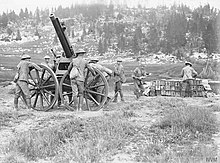
During World War I, both Britain and France sent military forces to Italy in October 1917.
Following the Battle of Caporetto (24 October to 19 November 1917), the Italian Front collapsed. In order to ensure this did not lead to Italy withdrawing from the war the allies organised forces to reinforce the Italians. As the battle unfolded, General Luigi Cadorna invoked the agreement reached at the Chantilly Conference of December 1915. There the allies had agreed that should any of the allies come under threat, the other allies would support them. The first French troops arrived on 27 October 1917. The first British troops followed them after a few days. Fearing that his troops would be overrun and lost in case the Italian lines on the Piave river would be broken by the Austro-Hungarian and German forces, however, General Foch refused to commit them to the frontline until the Italian troops had halted the Central Powers' troops by themselves and firmly established a defensive line on the Piave river. The British were thus kept in reserve during the First Battle of the Piave (November 1917) and only saw action from December 1917 onwards.

The French expeditionary force (fr:Forces françaises en Italie) consisted primarily of the French Tenth Army with the addition of the 12th Army Corps and 31st Army Corps. They took up station around Verona. Four of the six French divisions (46e, 47e, 64e, 65e) were to return to the Western Front in spring 1918, with the two divisions of 12th Corps remaining in Italy.

The British Expeditionary Force (Italy) came under the command of General Herbert Plumer. The principal units in the BEF(I) were the 23rd, 41st, 7th, 48th and 5th divisions. The 5th Division returned to France on 1 March 1918, followed by the 41st Division in April. Lieutenant General Cavan was appointed Commander-in-Chief of British Forces in Italy on 10 March 1918, comprising the three divisions of XIV Corps (United Kingdom).
Notes
- The French units were (i) 12th Army Corps (France) (ii) 10th Army (France) and (iii) 31st Army Corps (France) comprising (1) 23rd Division, 24th Division, (2) 46th Division, 47th Division and (3) 64th Division, 65th Division respectively.
References
- Craig Johnson, Robert. "After Caporetto: William Barker & the Italian Expeditionary Force". Rocky Mountain Chapter, IPMS/USA. Archived from the original on 13 April 2013. Retrieved 4 December 2013.
{{cite web}}: CS1 maint: bot: original URL status unknown (link) - Duffy, Michael. "The 2nd Inter-Allied Conference at Chantilly, 6 December 1915". Retrieved 4 December 2013.
- Pompé 1924, pp. 508–511, 730–731, 826.
- McKay, Frances. "Touring the Italian Front, 1917–1919". Retrieved 4 December 2013.
- "WWI Background & Ops -23 (Brit) Div". Archived from the original on 4 March 2016. Retrieved 4 December 2013.
- Oram, Gerard Christopher (2000),"What alternative punishment is there?”: military executions during World War I. PhD thesis, The Open University
- "No. 30966". The London Gazette (Supplement). 18 October 1918. p. 12483.
Further reading
- Capitaine Berthemet (1 January 1922). "Les troupes françaises en Italie pendant la Grande Guerre". Revue militaire française (in French) (7): 25–47.
- Cassar, George H. (1998). The Forgotten Front: The British Campaign in Italy, 1917–1918. London: Continuum International Publishing Group. ISBN 1-85285-166-X.
- Edmonds, J. E.; Davies, Sir Henry Rodolph (1949). Military Operations: Italy 1915–1919. History of the Great War based on Official Documents by Direction of the Committee of Imperial Defence. Maps in rear cover folder. London: HMSO. OCLC 4839237.
- Pompé, Daniel; et al., eds. (1924). Ordres de bataille des grandes unités – Divisions d'Infanterie, Divisions de Cavalerie [10,2]. Tome X. 2e Volume. Les armées françaises dans la Grande guerre. Based on Official Documents by Direction of the Ministère De la Guerre, Etat-Major de l'Armée – Service Historique (in French) (1st ed.). Paris: Imprimerie Nationale. Retrieved 14 August 2020.